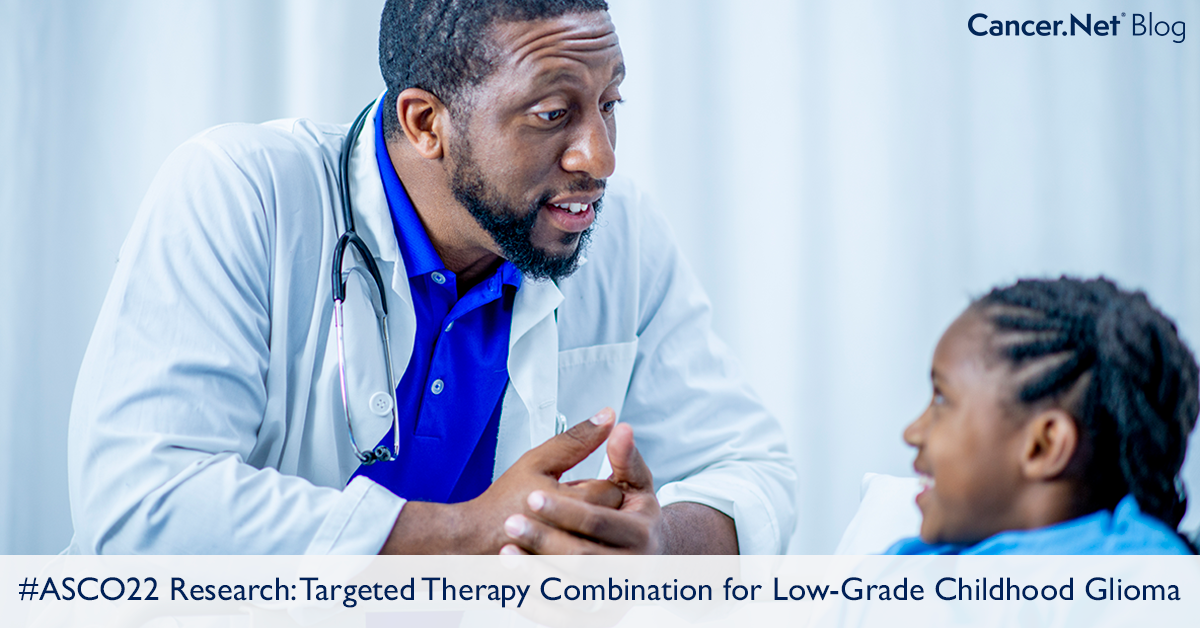
The theme of the 2022 American Society of Clinical Oncology (ASCO) Annual Meeting is Advancing Equitable Cancer Care Through Innovation. From June 3 to 7 in Chicago, Illinois, and online, cancer researchers and clinicians from around the world will gather to discuss the latest research and how to ensure that all people receive the cancer care they need.
ON THIS PAGE
Some of the notable research that will be presented today includes:
Targeted therapy combination helps shrink tumors in children with low-grade glioma with a BRAF V600 mutation
Who does this study affect? Children with low-grade glioma with a BRAF V600 mutation.
What did this study find? A phase 2/3 clinical trial found that a combination of targeted therapy medications using dabrafenib (Tafinlar) and trametinib (Mekinist) helped shrink tumors in children with low-grade glioma with a BRAF V600 mutation more effectively than the current standard-of-care chemotherapy.
A BRAF V600 mutation is a specific change in the tumor’s BRAF gene that is found in about 15% to 20% of low-grade gliomas in children. Gliomas are a type of brain tumor that start in glial cells, which are supportive cells in the brain. They are classified by their location and the type of glial cell they start in and include astrocytoma, oligodendroglioma, ependymoma, and brain stem glioma. Gliomas are assigned a grade to indicate how aggressive a tumor is likely to be, with lower grades being less aggressive. Low-grade glioma is the most common type of brain tumor in children.
Low-grade glioma cannot always be fully removed with surgery, so patients often require additional treatment with chemotherapy. However, chemotherapy may be less effective in tumors with a BRAF V600 mutation. Dabrafenib is a targeted therapy that works by targeting the BRAF mutation, and trametinib is a targeted therapy that targets the MEK protein, which is involved in cancer growth and survival. In this study, researchers wanted to see whether treating low-grade glioma with a BRAF V600 mutation using dabrafenib with trametinib was more effective than the current standard-of-care chemotherapy combination, which has been used for decades.
This study included 110 children and teens (ages 1 to 17) with low-grade glioma with a BRAF V600 mutation. The participants were randomly assigned to receive either the targeted therapy combination of dabrafenib with trametinib (73 participants) or the standard chemotherapy combination of carboplatin with vincristine (37 participants).
After a median follow-up of nearly 19 months, the overall response rate, which is the percentage of children and teens whose tumors shrunk from the treatment, was significantly higher in the targeted therapy group (47%) than in the chemotherapy group (11%). The median is the midpoint, meaning half of the participants were followed for less than 19 months and half were followed for longer. Additionally, the percentage of participants whose tumors either shrunk or did not grow for at least 6 months after treatment was nearly doubled in the targeted therapy group (86% of participants) compared with the chemotherapy group (46% of participants). This is called the clinical benefit rate. And, the targeted therapy combination delayed cancer growth for significantly longer than the chemotherapy combination (20.1 months versus 7.4 months, respectively).
Half as many participants in the targeted therapy group experienced serious side effects as those in the chemotherapy group (47% of participants versus 94% of participants, respectively). Fewer participants in the targeted therapy group needed to end treatment early due to serious side effects (4% versus 18%, respectively). The most common serious side effects in the targeted therapy group were fever, headache, and vomiting.
What does this mean for patients? This study shows that the combination of dabrafenib with trametinib may be more effective at shrinking low-grade childhood gliomas with a BRAF V600 mutation than the current standard-of-care chemotherapy. The targeted therapy combination treatment also causes fewer side effects than chemotherapy.
“For pediatric patients with BRAF V600-mutant low-grade glioma, dabrafenib plus trametinib may offer an improved standard of care. This represents an important advance for the youngest patients with brain cancer, as this is the first combination of targeted therapies developed for patients as young as one year of age.”
— Eric Bouffet, MD, FRCPC
The Hospital for Sick Children
Toronto, Canada
Stay Informed
Visit the Cancer.Net Blog each day of the meeting for more scientific highlights from the 2022 ASCO Annual Meeting and how the new research will affect patient care. You can also keep up with the meeting’s news by following Cancer.Net on Facebook and Twitter, where you can follow the #ASCO22 hashtag.
Like what you’ve read here at Cancer.Net? Sign up for our monthly Inside Cancer.Net e-newsletter.






